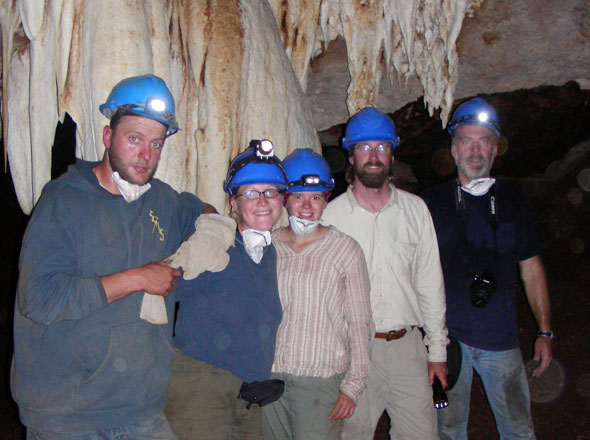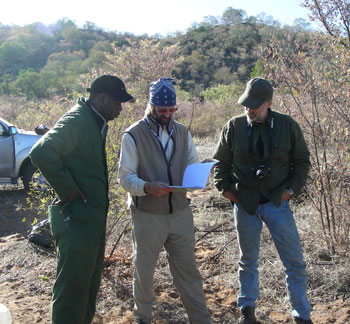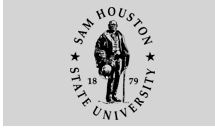Biology Profs, Students Dig Into Africa
 |
SHSU graduate student Tim Campbell,
Texas A&M graduate student Juliet Brophy, SHSU junior
Alicia Kennedy, assistant professor of biology Patrick
Lewis and biology professor Monte Thies (from left)
explore a cave in the Republic of Botswana that has
had very few westerners inside as part of an archaelogical
dig for fossils over the summer. —Submitted photo. |
The nearest water was more than five hours away; the nearest
doctor, as many as four days away.
They slept in tents, had no running water, subsisted mostly
on canned food, spent their days digging in the dirt and traveled
with a foreign military.
It may not sound like an ideal way to spend your summer, but
it was all in a day’s work for several members of SHSU’s
biological sciences department.
Assistant professor of biology Patrick Lewis, biology professor
Monte Theis, junior Alicia Kennedy and graduate student Timothy
Campbell were part of a team that spent six weeks this past
summer in South Africa’s Free State Province and the
Republic of Botswana, exploring cave sites and extracting
fossils dating from one to four million years old.
South Africa’s Free State Province
In the 1950s, the South African government was digging through
a hill to put in a railway, and while doing so, they exposed
buried sediments and fossils, including a 6-foot long mammoth
tusk.
Now known as the Meloding Railway Cut site, it has been dated
to be over four million years old, according to Lewis, who
has been working in South Africa since 2002 and is co-directing
the current project with Darryl de Ruiter from Texas A&M
University.
“This is a time period in southern Africa that there’s
virtually nothing known about, so it’s a real exploratory
spot,” he said.
The SHSU team spent about a month in the area, using a big
backhoe in a field next to the railway cut to remove the sediment
layer that was on top of the fossil layer and excavated a
15-meter square, he said.
They then set up one-by-one grids, “like you would see
in archeological excavations” to sort through and screen
dirt.
“We found about 24 different species, from the mammoth
down to lizards to rodents, antelopes, birds, horses, fish.
We have a really diverse group,” Lewis said. “One
of the students found a great big mammoth tooth.”
One “exciting” find for Kennedy included the mandible
and maxilla of a lizard, “tiny little things,”
Campbell said.
The fossil lizard is Kennedy’s area of interest, or
“focus organism,” as an undergraduate.
“I like them because they are environmentally sensitive,”
she said. “We try to reconstruct the environments that
they came from. When you look at different animals from a
time period, you can see the environmental requirements they
had, if they’re tropical (for example).”
The fossils uncovered by the SHSU team are still in South
Africa. Lewis focuses on the small animals, and when these
fossils are brought to SHSU they will be analyzed in his lab
with the assistance of several students and colleagues.
“It’s a lengthy process (bringing fossils back
to America),” Lewis said. “You dig things up,
and then you have to go back and get a permit to actually
borrow the things you dug up, so it can take a whole year
to get access to the fossils.”
Republic of Botswana
 |
Gabidirwe, curator of paleontology
for the Botswana National Museum, Lewis and Thies discuss
their course of action before going inside the Tswana
cave. Part of the SHSU team's goal is to build relationships
with the Batswana so they can take over excavation when
the team leaves. —Submitted Photo.
|
Through his work in South Africa, Lewis became aware of the
Republic of Botswana as an area that could provide him with
information relevant to his research interests.
Botswana is located in southern Africa, nestled between South
Africa, Namibia, Zimbabwe and Zambia.
This year, he and a team were given the opportunity to work
with the Botswana National Museum to begin the process of
excavating a cave site that preserves fossils between two
million and a half million years old.
“We, as a lab, are real interested in this period because
modern humans are evolving in Southern Africa at this time,”
he said. “We are trying to learn more about what the
environment was like during that period to try to understand
what might have been driving human evolution in the area.”
The team of about 20, including Botswana people, spent approximately
12 days in the area for what Lewis called a “feeling
out process.” At that time, the cave site hadn’t
been thoroughly explored, and very few westerners had ever
even been inside, Lewis said.
“This year in Botswana was really geared toward seeing
if we can work out there, if there was anything there to find
and if we could get the support of the Batswana to help us
to do it,” he said.
It was a much more physical trip than the South Africa dig,
he said.
“We were having to squeeze through crevices full of
bats and spiders, so it’s not a pleasant place to work,”
Lewis said.
“There were spots where the only way to get through
was to get on your back and kind of wriggle down, which is
difficult, especially for someone Tim’s size,”
he said of the 6-foot-4-inch Campbell. “There were cracks
and holes that you had to crawl through that would open up
to bigger pits.”
The Experience
After years of taking students to Africa, Lewis said one
of the things he tries to do is to make sure students understand
what they can expect so they won’t experience “culture
shock.”
“Particularly going on a professional project, it’s
often hard for students,” he said. “I’ve
taken students to Botswana, and they freak out with lions
roaring in the background and people talking in foreign languages.”
The team was in Africa during its winter, and temperatures
ranged from the 80s during the day to as low as the 20s at
night.
“I wasn’t expecting South Africa to be so…it
was a lot like being here,” Kennedy said. “It
looks like Texas, so I didn’t feel like I was really
in Africa when we were in South Africa.”
Botswana was another story. The remote country has only “one
good road,” Kennedy said, with Campbell adding that
it was “20 miles past nowhere.”
In addition, it has the highest HIV rate in the world, as
well as issues with alcoholism.
“None of us, myself included, had been that far out,”
Lewis said. “To be that far away from everything is
really neat. The whole time you feel like you’re on
a journey, this quest, and there’s just this uncertainty
that adds an edge of excitement to the whole thing.”
Adding to the uncertainty, at least at first, was the fact
that they had to travel with the Tswana military, which has
a semi-permanent camp nearby.
“We really didn’t expect it,” Lewis said.
“We didn’t know what they were there for, and
my rule is usually the fewer guns at camp, the better.
“But once we got out there, (we saw that) Botswana has
no fences, and there were leopard prints and lions,”
he said. “Then it’s a little nice to have the
army guys out there to keep an eye out.”
“They were really curious about everything we were doing,
about the States,” Campbell said. “I would chat
them up a lot; their view of the world and their view of American
culture is a lot different than you’d expect.”
One of Botswana’s official languages is English.
The work itself was dirty; “miserable” even, they
said.
“People think it sounds cool, but you don’t really
understand how uncomfortable you are and how you get dirty,
and you just smell awful,” Lewis said. “The caves
are filled with bat guano, so you’re crawling through
bat guano and there are bugs and it’s hot, and then
when you get out, there are no showers.
“We had enough (water) to kind of splash, but we’d
have to take all of our clothes and immediately put them in
bags,” he said. “If we were smart we would have
burned them all.”
“We got back into a bigger town, and we gave our clothes
to these ladies who wash clothes for you,” Kennedy said.
“When we got them back, and they charged us extra because
they were excessively dirty.”
Professional Implications
The team was able to go to Africa through a number of grants
they obtained specifically for the purpose, including funding
from the College of Arts and Sciences.
“The opportunity for an undergraduate to go to Africa
and work on a real professional crew is extremely rare,”
Lewis said.
Campbell, who had taken a year off after graduating from the
University of Rhode Island but had been to Africa twice previously,
was recruited for SHSU’s biology graduate program after
working with Lewis in Africa.
“He worked really hard and he’s obviously really
smart and is really curious about stuff, and those are the
kinds of students you want to go after,” Lewis said.
“I honestly thought his interests were better suited
here than the place he was thinking about going.”
Both Kennedy and Campbell would like to stay in academics
as a career. Kennedy even “generated the contacts needed
to continue with her scientific career, with the next step
being a PhD program at the University of Texas,” said
biology department chair Matthew Rowe.
“It was wonderful,” Kennedy said. “I’m
ready to get back. We’re already working on getting
more grants and raising more money.”
In preparation for next year, Lewis is taking his students
to SHSU’s rock climbing wall for practice. They’re
also planning on collecting books and supplies to send to
villages.
“We want to build relationships with the Batswana and
train some people that are there so they can better understand
the process,” Lewis said. “We can’t work
there forever, and when we leave they can continue to be invested
in the science and the fossils there.”
—END—
SHSU Media Contact: Jennifer
Gauntt
Sept. 5, 2007
Please send comments, corrections, news tips to Today@Sam.edu.
|


